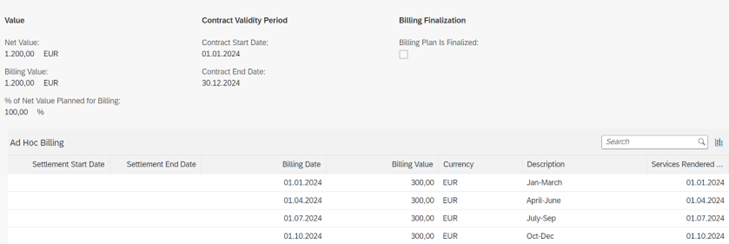
2023-10-30 04:24:29 Author: blogs.sap.com(查看原文) 阅读量:7 收藏
In this blog, I want to unpack the complexity of how revenue recognition takes place in Service Contracts with ad-hoc billing. With the normal item categories SCN1 and SCN2, the system automatically creates billing request lines with a planned billing value and settlement start and end dates, depending on the settlement period selected.

With ad-hoc billing (SCN3) however, the system doesn’t know in which frequency and for which billing values the billing request lines (BRL) will be created. Due to this, revenue recognition cannot be planned in advance as with the other two item categories. This is also the reason why the “Billing Plan Is Finalized” flag must be set, so that the system knows that no further BRLs will be created
With this background, let’s now look at the two important characteristics that determine how revenue recognition takes place for these ad-hoc billing items.
- Contract item net value
- Settlement Start Date and Settlement End Date (optional)
Let’s now look at a basic example of a service contract item using ad-hoc billing. The contract item start date is 01.01.2024 and the end date is 31.12.2024. The net value of the contract item is 1200€
RevRec without settlement start and end dates
- In this case, the system divides the contract item net value by the time frame of the contract item duration (1200€/12 months = 100€). Irrespective of the ad-hoc billing amount, this calculated revenue of 100€ will be realized monthly. Let’s say the invoices are billed to the customer on the first of Jan, April, July and October with an invoice amount of 300€ each.

- The revenue recognition runs would look something like this:

RevRec with settlement start and end dates
- If the user now additionally specifies the settlement start and end dates for each invoice (BRL), the system distributes the recognition of revenue slightly differently. The contract item net value is no longer divided by the total duration of the contract item, rather by the duration of the settlement period of the BRL.
- Let’s consider a slightly different example this time, with the settlement dates optionally being specified this time. Note that the invoice amounts are also slightly different each quarter – this will illustrate the difference that maintaining the settlement dates brings about.

- This time, the revenue recognition runs would look something like this:

- If the settlement dates weren’t specified, the monthly recognized revenue would have continued to be a constant 100€ per month despite the fluctuations in the invoice amounts during the course of the year.
Hope this blog gave you some insight into the behind the scenes of revenue recognition with ad-hoc billing service contracts in S/4HANA Cloud.
如有侵权请联系:admin#unsafe.sh